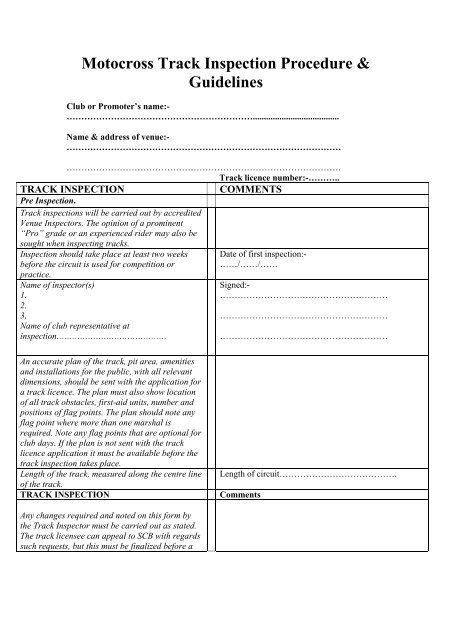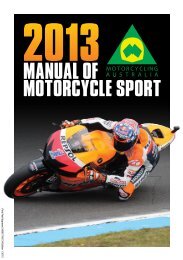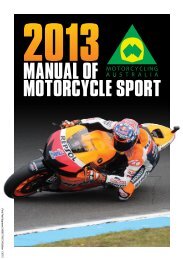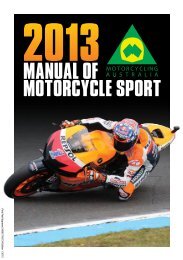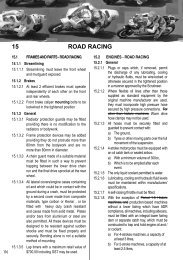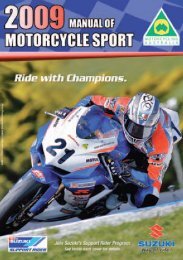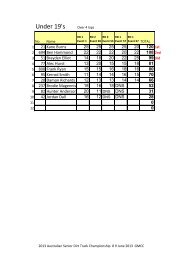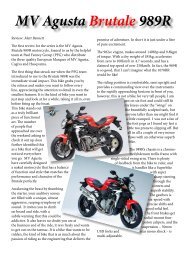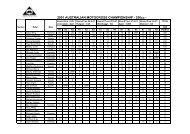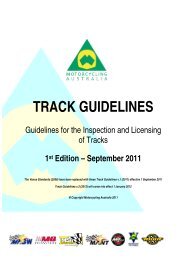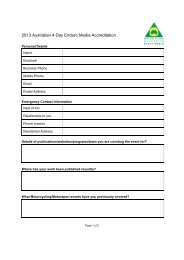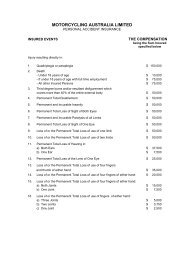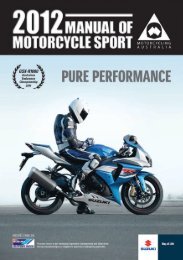Motocross Track Inspection Procedure & Guidelines - Motorcycling ...
Motocross Track Inspection Procedure & Guidelines - Motorcycling ...
Motocross Track Inspection Procedure & Guidelines - Motorcycling ...
You also want an ePaper? Increase the reach of your titles
YUMPU automatically turns print PDFs into web optimized ePapers that Google loves.
<strong>Motocross</strong> <strong>Track</strong> <strong>Inspection</strong> <strong>Procedure</strong> &<strong>Guidelines</strong>Club or Promoter’s name:-……………………………………………………….......................................Name & address of venue:-……………………………………………………………………………………………………………………………………………………………………<strong>Track</strong> licence number:-………..TRACK INSPECTIONCOMMENTSPre <strong>Inspection</strong>.<strong>Track</strong> inspections will be carried out by accreditedVenue Inspectors. The opinion of a prominent“Pro” grade or an experienced rider may also besought when inspecting tracks.<strong>Inspection</strong> should take place at least two weeks Date of first inspection:-before the circuit is used for competition or……/……/……practice.Name of inspector(s)1.2.3.Name of club representative atinspection……………………………………Signed:-………………………………………………………………………………………………………………………………………………………An accurate plan of the track, pit area, amenitiesand installations for the public, with all relevantdimensions, should be sent with the application fora track licence. The plan must also show locationof all track obstacles, first-aid units, number andpositions of flag points. The plan should note anyflag point where more than one marshal isrequired. Note any flag points that are optional forclub days. If the plan is not sent with the tracklicence application it must be available before thetrack inspection takes place.Length of the track, measured along the centre lineof the track.TRACK INSPECTIONLength of circuit………………………………….CommentsAny changes required and noted on this form bythe <strong>Track</strong> Inspector must be carried out as stated.The track licensee can appeal to SCB with regardssuch requests, but this must be finalized before a
<strong>Motocross</strong> <strong>Track</strong> <strong>Inspection</strong> <strong>Procedure</strong> &<strong>Guidelines</strong><strong>Track</strong> Licence can be issued. The track can beapproved at the first inspection with small changesif necessary, noted.<strong>Track</strong> inspection fees are charged as follows:• MQ <strong>Inspection</strong> fee $40• Time for track inspectors, including travel$20/hour• Inspectors travel 40c/klmklms traveled @ 40c/klmCost $..........................
<strong>Motocross</strong> <strong>Track</strong> <strong>Inspection</strong> <strong>Procedure</strong> &<strong>Guidelines</strong>1.0 INSPECTIONS AND LICENSING1.1 Time framesVenues, excluding temporary venues, must be inspected on an annual basis taking into account thefollowing:a) The inspection and its subsequent report shall outline the conditions of licensing and a works programme(if required) to be carried out in years 1, 2 and 3. This process will continue on a triennial basis.b) An inspection will take place after years 1 and 2 and will ensure the works programme is beingmaintained and will ensure that general maintenance is being carried out at an acceptable level. These minorinspections will ensure there is no deterioration in the venue or its infrastructure.1.2 PlansPrior to a major inspection the venue operator shall provide to the RCB a plan of the venue. In the case of aroad racing venue the plans shall be what is generally accepted as scale drawings (to a drafting standard). Inthe case of other venues a proper drafted drawing is desirable but a lower standard of drawing maybeacceptable provided it is reasonably to scale and provides sufficient detail of the layout, lines of protectioninfrastructure the geographical and architectural features of the venue.1.3 RegulationsThe onus rests with the venue operator to ensure the venue meets any environmental, town planning,building, safety or other local government or state government regulations. Furthermore the onus ofcompliance with any local government, state government or statutory permits rests with the venue operator.1.4 G.P.S. Co-ordinatesThe venue operator must provide, in the application for a venue licence, the G.P.S. co-ordinates of thevenues. These co-ordinates must be listed on the venue licence. The G.P.S. co-ordinates must identify anapproved place for an emergency helicopter to land.1.5 Venue LicenceThe current venue licence or a facsimile thereof must be prominently displayed in the main eventmanagement office e.g. Race Secretary’s office and or Control Tower. The licence must stipulate thenumber of competitors allowed for racing and practice.1.6 Venue Licence Conditions1.6.1 The Venue licence shall state any specific licensing conditions which maybe applicable to that venue(i.e. the installation of air fence at road racing venues”).A plan of the circuit must be attached to the venue licence. The plan must show the location andnumber of track marshals necessary for competition, practice or a ride day to take place. Thenumbers may vary for competition, practice and a ride day. The plan shall also show the location ofmedical facilities and the parking position of first aid / ambulance vehicles if they are required.
<strong>Motocross</strong> <strong>Track</strong> <strong>Inspection</strong> <strong>Procedure</strong> &<strong>Guidelines</strong>2.0 LICENSING PROCEDURES2.1 Venue Standards2.1.1 The purpose of this module is to assist relevant controlling bodies, venue owners and operators andpromoters to license and maintain their venues to the national standard.2.1.2 Detailed venue standards are listed in this module for:a) Road Racingb) <strong>Motocross</strong>c) Stadium <strong>Motocross</strong>d) Supercrosse) Speedwayf) <strong>Track</strong>g) Dirt <strong>Track</strong>h) Supermoto, andi) Temporary Courses2.1.3 In some states or territories of Australia, various government authorities may also be involved in licensingvenues. RCBs, circuit owners or operators and promoters should ensure that they are familiar with any localordinances or laws that may apply to any venue within their jurisdiction. Venue inspections may need to becarried out in the presence of representatives from other authorities such as police, local government andstate and territory government departments.2.2 Documentation2.2.1 For road race circuits, applications for licensing must include sufficient documentation to indicatecompliance with these standards. The application must include, but not necessarily be limited to an accurateplan of the circuit, based upon survey by a licensed land surveyor, presented in both paper and digital formatto show:a) the racetrack proper;b) a diagram of speeds which shows an overlay of the run-off distances on every corner;c) the location, extent, height and construction type of the first line of protection;d) the location, extent, height and construction type of the second line of protection;e) the location, extent and cross section of all kerbing;f) the location and extent of pit entry / exit roads;g) the location and type of all braking markers;h) an accurate representation of the grid markings;i) the location and extent / size of all marshal points;j) level information over the area of the racing arena to an accuracy of +/-200mm;k) any other features within the racing arena as defined in 3.6 and 3.7 of this module;l) the location and number of competitor and spectator toilet/shower facilities;
<strong>Motocross</strong> <strong>Track</strong> <strong>Inspection</strong> <strong>Procedure</strong> &<strong>Guidelines</strong>m) the location of first aid rooms/units;n) the location of Ambulance’s parking site and entrance to racing arena;o) the GPS location of the circuit for emergency evacuation.2.2.2 For other venues excluding temporary venues of a course length greater than 5 kilometres, applications forlicensing must include a scaled drawing of a minimum scale of 1:2000 of the track and surrounds, whichmust include the following:a) the racetrack proper, including location of start/finish line;b) the location, extent, height and construction type of the first and second line of protection;c) the location and extent of pit entry / exit roads;d) the location and extent/size of all marshal points;e) details of the track watering system and any other features within the racing arena;f) the location and number of competitor and spectator toilet/shower facilities;g) the location of first aid rooms/units;h) the location of the Ambulance parking site and entrance to the racing arena;i) the GPS location of the circuit.2.3 DefinitionsFor the purpose of these standards, the following definitions or interpretations apply:2.3.1 Approval of Circuit - A circuit must not be licensed for competition held under an MA permit unless theInspecting procedure specified herein has been complied with and that the RCB has been satisfied thecriteria contained herein have been adopted or that an exception is warranted and that exception presentsan acceptable risk.2.3.2 Arena Cross – See stadium motocross.2.3.3 CAMS - Confederation of Australian Motor Sport.2.3.4 Circuit - A road or track beginning and ending at the same point, which can be either of a temporary orpermanent nature.2.3.5 Closed Circuit or Course – The whole or part of a circuit or course only accessible to competitionmachines.2.3.6 Course – A track that need not start and end at the same point.2.3.7 Curve - A change in direction through an angle greater than 15 degrees with a radius of less than threehundred (300) metres.2.3.8 FIA – Federation Internationale Automobile – the international automobile federation.2.3.9 FIM – Federation Internationale de Motorcyclisme – the international motorcycle federation.
<strong>Motocross</strong> <strong>Track</strong> <strong>Inspection</strong> <strong>Procedure</strong> &<strong>Guidelines</strong>2.3.10 GPS – Global positioning system.2.3.11 Jump – An obstacle that would reasonably require that a machine negotiating it would become airborne.2.3.12 Lines of Protectioni) First line of protection - the barrier closest to the track which acts to prevent motorcycles andriders from colliding with spectators and officials or prevents them from crossing other parts of thecircuit.ii) Second line of protection - A fence or barrier required to prevent the public entering the racingarena.Note: In some natural terrain off road circuits the lay of the land may suffice as a first line of protection.2.3.13 MA –<strong>Motorcycling</strong> Australia.2.3.14 MANSC - <strong>Motorcycling</strong> Australia’s National Safety Committee.2.3.15 <strong>Motocross</strong> - A competition that is held on a outdoor circuit of natural terrain which may have man-madeobstacles.2.3.16 Multiple Jump – An obstacle that consists of two to a maximum of four jumps within 10 metres of eachpreceding jump on a straight section of the course. It is not necessary to deem that the jumps may beable to be jumped singly or as a set.2.3.17 May - Indicates a recommendation.2.3.18 Must - Indicates a requirement.2.3.19 Natural Terrain <strong>Motocross</strong> – A competition that is held on a temporary or permanent outdoor circuit thatis set out using the natural contours of the site and has no man-made obstacles.2.3.20 Obstacle – In <strong>Motocross</strong> / Supercross / Stadium <strong>Motocross</strong> a Jump, Multiple Jump (not permittedmotocross), Whoop Section, Stutter Section (not permitted motocross), Table Top Jump. No otherobstacle is defined for the purpose of these standards. For Enduro and Moto-Trials an obstacle can beany challenge to a competitor and machine during the course of a competition.2.3.21 Neutral Zone – the area between the first and second lines of protection.2.3.22 Parc Ferme – An area where machines are impounded and access may be restricted in accordance withthe regulations for the event.2.3.23 Race Line - The ideal trajectory which is followed by the competitors under competition conditions, andwhich may not correspond to the geometric shape of the circuit.
<strong>Motocross</strong> <strong>Track</strong> <strong>Inspection</strong> <strong>Procedure</strong> &<strong>Guidelines</strong>2.3.24 Racing Arena - An area including the racing circuit proper and extending at a minimum to where the"second line of protection" would need to be placed (infield and outfield) behind run-off areas ofdimensions calculated for “new circuits” as defined within these standards.2.3.25 RCB – the relevant controlling body. The body (either MA or a State Controlling Body) with jurisdictionover a permitted meeting or licensed venue.2.3.26 Run-Off Area - The area on the outside of curves extending from the track to the first line of protection(or barrier).2.3.27 Safety Fence – also known as the first line of protection - the barrier closest to the track which acts toprevent motorcycles and riders from colliding with spectators and officials or prevents them fromcrossing other parts of the circuit.2.3.28 Spectator Fence – also known as the second line of protection - A fence or barrier required to prevent thepublic entering the racing arena.2.3.29 Speed Diagram - A table or diagram indicating the maximum speeds attainable in the straights andcurves of the circuit calculated in accordance with the data provided in section 3, figures 1, 2 and 4.2.3.30 Start Gate – the mechanical apparatus behind which the motorcycles are assembled to start an event.2.3.31 Stadium <strong>Motocross</strong> – A competition held on a temporary or permanent indoor or outdoor circuitpredominantly consisting of man made obstacles within an arena or stadium and which does not includemultiple jumps or stutters.2.3.32 Start Pad – The area immediately behind the start gate where the machines are lined up ready tocommence the competition.2.3.33 Stutter Section – Two or more obstacles with a maximum height of 1 metre, a minimum distancebetween peaks of 1 metre and a maximum distance between peaks of 3 metres.2.3.34 Supercross – A competition held on a permanent or temporary indoor or outdoor circuit predominatelyconstructed of man-made obstacles in an arena.2.3.35 Table Top Jump – An obstacle with a flat surface with a minimum length of 3 metres and a maximumlength of 18 metres.2.3.36 <strong>Track</strong> – The paved or unpaved surface on which competition takes place.2.3.37 Verge - The area immediately between the track and the first line of protection.2.3.38 Whoop Section – Two or more rounded obstacles with a maximum height of 0.6metre, a minimumdistance between crests of 3 metres and a maximum distance between crests of 6 metres.
<strong>Motocross</strong> <strong>Track</strong> <strong>Inspection</strong> <strong>Procedure</strong> &<strong>Guidelines</strong>2.4 Venue Maintenance2.4.1 Venues are to be maintained to the standards as outlined in the discipline guidelines, which follow.2.4.2 Venues should be constructed and maintained taking heed of all relevant legislation and local councilbylaws for sporting facilities, public parks, health and building codes.2.5 Notices to the PublicAt all meetings to which the public have access, other than Reliability Trials on a public road, a variety of writtennotices or warnings are required. The notices or warnings are detailed in Chapter 4 of the Manual of MotorcycleSport under the heading “Notices to the public”. These notices or warnings are mandatory and an integral part of thevenue licensing procedures. Failure to display these notices or warnings may invalidate a venue licence. Thesenotices are also detailed as follows:The following standard notice warning the public that motorcycle competition occurs at the venue.WARNING TO THE PUBLICMotor racing is DANGEROUS, and spectators attending this trackdo so entirely at their own risk. It is a condition of admission that allpersons having a connection with the promotion, and/ororganisation, and/or conduct of the meeting, including the owners ofthe land and the riders and owners of vehicles and passengers in thevehicles, are absolved from all liability arising out of the accidentscausing damage or personal injury to spectators or ticket holders,except where due care and skill has not been exercisedWherever at such meetings, it is considered desirable by the promoters of the meetings, or is a condition of thegranting of a Venue Licence that the public shall be excluded from a certain area. The following standard form ofnotice prohibiting the public from access to that area shall be prominently displayed.PROHIBITED AREAThe Public is not permitted in thisarea.No other form of notice for warning the public generally or for prohibiting access to certain areas shall be displayed.The standard form of notice as shown above measures 550mm x 450mm.
<strong>Motocross</strong> <strong>Track</strong> <strong>Inspection</strong> <strong>Procedure</strong> &<strong>Guidelines</strong>A sign must be prominently displayed in pit areas warning that the carrying or consumption of alcoholic beveragesby all personnel in the area is prohibited. The sign shall measure 550mm x 450mm and shall read:WARNINGThe carrying or consumption of alcoholic beverages in the pit area isprohibited.By Order,<strong>Motorcycling</strong> Australia LtdAt the entrances to any venue a promoter must prominently display the following sign:NOTICENo Animals Allowed.Guide Dogs ExceptedBy Order,<strong>Motorcycling</strong> Australia LtdPit areas must be clearly defined. A promoter must prominently display the following sign at the entrance to the pitarea. In all pit areas the following rule will apply:2.6 Annual <strong>Inspection</strong>sThe riding of motorcycles in the pit area is only allowed in markedaccess lanes.By Order,<strong>Motorcycling</strong> Australia LtdAll venues must be inspected annually (taking into account 1.1). Prior to be re-licensed. <strong>Inspection</strong>s are to becarried out in accordance with the discipline guidelines, which follow.STANDARDCOMMENTS4.0 VENUE STANDARDS – <strong>Motocross</strong>4.1 ScopeCOMPIESCOMPLIESWITH TRAFAILS4.1.1 These standards define the conditions, which mustbe satisfied before a motocross venue can belicensed for as in <strong>Motorcycling</strong> Australia (MA)permitted event.
<strong>Motocross</strong> <strong>Track</strong> <strong>Inspection</strong> <strong>Procedure</strong> &<strong>Guidelines</strong>4.1.2 Alternative solutions to meeting safetyrequirements, or exceptions to these standards,may be permitted upon presentation of satisfactorysupporting information to the RCB in the form of aRisk Assessment in accordance with theprocedures as outlined in Appendix A.4.2 Application4.2.1 Except as noted above, all venues must beconstructed according to these standards andshould take into account all local council by-lawsfor sporting facilities, public parks, health andbuilding codes.4.3 <strong>Track</strong> Layout4.3.1 <strong>Track</strong> layout must be initially designed with allgrades of riders in mind; particular attention to theinstallation, consistency and shape of any jumpfaces is a priority. The track surface materialsused have to be exclusively natural.4.3.2 Riders, officials spectator safety and location mustbe taken into account when licensing a venue.4.3.3 In general a track should be designed with minimalstop/start turns. The track should be designed toallow for safe passing.4.3.4 Consideration should be given to drainage in theevent of heavy rainfall.4.3.5 Jumps and obstacles should vary in difficultymaking it possible for the different levels of ridersto demonstrate their skills.
4.4 <strong>Track</strong> Dimensions<strong>Motocross</strong> <strong>Track</strong> <strong>Inspection</strong> <strong>Procedure</strong> &<strong>Guidelines</strong>4.4.1 All motocross tracks will have a minimum lengthof 800m and a maximum length of 3km.All motocross track used for State and NationalChampionships will have a minimum length of1.5km and a maximum length of 3km4.4.2 The minimum width at any point on the track willbe six (6) metres. <strong>Track</strong>s with more than 30 gateswill be at least seven (7) metres wide.4.4.3 The free space between the track and any obstacleabove the ground must be three 3.5 metreminimum. (e.g. bridges, bunting etc). In specialcircumstances, if there are obstacles, which cannotbe easily moved or changed, then this space maybe reduced with the use of suitably approved shockabsorption material. The use, and type, of thismaterial must be highlighted on the track diagram.4.4.4 The track must not contain any high-speedsections (i.e. where speeds exceed 100kph).4.4.5 Average Speed: The maximum average speed fora lap of the track is to be no greater than 55kph.The formula to work out the average track speedis:Average Speed (kph) = Distance (metres)LapTime (secs) x 3.6Note that the lap time used is to be one achievedby an experienced “Pro” grade rider.As an example:<strong>Track</strong> length = 1,750 metresLap time = 119 secondsTherefore: Average Speed (kmh) = 1750 metres119 seconds x 3.6= 52.94 kph
<strong>Motocross</strong> <strong>Track</strong> <strong>Inspection</strong> <strong>Procedure</strong> &<strong>Guidelines</strong>4.4.6 Start Gate:a) The starting area should be clearly fenced off torestrict entry.b) The placement of the start gate must allow for equalchances for all competitors.c) There must be an individual gate for each rider.d) The starting gate must be a transverse backwardfalling device, folding or dropping in operation.e) The start gate must be of solid and rigid construction.f) It may be controlled manually or by remote controland the control mechanism must not be visible to thecompetitors when starting in the race.g) The start gate must be 500 mm high and allow a onemetrespacing (centre to centre) for each competitor.h) For Australian Championship meetings the start gatemust allow for up to 40 competitors (40 metres wide)in one single line with no second row.i) For club level meetings a starting mechanism otherthan gates may be allowed.j) Where concrete is used to secure the start gate, it mustnot exceed 600 mm in width.k) The starting pad immediately behind the start gatemaybe of concrete or similar solid construction toallow riders to start on a firm base allowing equally forall participants. A rear barrier must be installed at thestart gate, in order to prevent riders from moving theirmachines backwards. The distance between thestarting gate (released) and the rear barrier must bethree (3) metres.4.4.6 Start Straighta) There will be no jumps on the start straight.b) The maximum / minimum length of the start straightto the first corner will be 125 / 70 metres to the insideof the first corner.c) The start straight must taper to a minimum width of 12metres at the first corner and must maintain the widthof the start gate for the first 50% of its length.d) The width of 12 metres must be maintained for theentire radius of the first corner.
4.4.8 Obstacles<strong>Motocross</strong> <strong>Track</strong> <strong>Inspection</strong> <strong>Procedure</strong> &<strong>Guidelines</strong>The following are the only obstaclespermitted in motocross. The safety ofriders, spectators and officials must begiven utmost priority when constructingjumps and obstacles.4.4.8.1 Jumps:a) There will be no multiple jumps.b) Jumps should not exceed 3 metres in height.c) When approving jumps consideration must be given tothe age and ability of competitors.4.4.8.2 Table Top Jump – An obstacle with a flatsurface with a minimum length of 3 metresand a maximum length of 18 metres.4.4.8.3 Whoop Section – Two or more roundedobstacles with a maximum height of0.6metre, a minimum distance betweencrests of 3 metres and a maximum distancebetween crests of 6 metres.4.4.9 Pit Board Area:An area for signalling, which is visible to allriders, may be provided and clearly marked at asuitable place adjacent to the track. If provided itmust be clearly marked off with an entrance andexit to the track pit area.A Pit Board area must have a barrier to protectsignallers from oncoming bikes and to keepsignallers off the track.4.4.10 Bridges:a) Bridges are not permitted for new venues.b) Bridges currently in use at an existing circuit must beremoved by 31 December, 2008 unless:i) A written report from a qualified structuralengineer is produced each year signifying thestructural integrity of the construction.ii) Suitable barriers are in place to prevent machines,riders and debris from falling on to the tracksurface below.
<strong>Motocross</strong> <strong>Track</strong> <strong>Inspection</strong> <strong>Procedure</strong> &<strong>Guidelines</strong>4.4.11 <strong>Track</strong> Markers:a) The entire length of the track must be clearly defined.Plastic breakable tape may be used. Straw bales or cartyres can be used at intervals as additional trackmarkers, however these are not to be placed on jumptake-off or landing ramps.b) If car tyres are used they must not be dug into theground, but laid flat. Tyres may be stacked on top ofone another. If tyres are stacked they must be boundtogether. Tyres stacked or bound together must be ofthe same diameter i.e. all 14" or all 15"'. Truck ortractor tyres are prohibited.Tyres laid flat on the ground to mark the track must bea group of two tyres (minimum) and bound together.Where tyres are used to mark the apex of a corner thestack must be a minimum of three tyres boundedtogether. The bottom tyre must be filled with earth tostabilise the stack.c) Any marking poles should be flexible and placed in anoutward angle from the track.i) The use of any rope bunting is banned.ii) The use of rigid posts (e.g. iron star pickets) is banned.iii) Marking poles should not exceed 500mm aboveground level.iv) Wooden stakes are permitted but cannot be larger than25mm x 25mm.d) Coloured plastic cones (as used to mark football fieldsetc.) can be used provided they are no greater than100mm in height.4.4.12 Parc Ferme:A Parc Ferme must be provided forall Australian Championship meetings. It mustbe designed to accommodate 40 machines andshould be in close vicinity of the starting area.4.4.13 Mechanics Area:a) For Australian Championship meetings, a mechanicsarea must be provided and clearly marked at a suitableplace adjacent to the track. It must be clearly markedoff with an entrance and exit to the track proper.
<strong>Motocross</strong> <strong>Track</strong> <strong>Inspection</strong> <strong>Procedure</strong> &<strong>Guidelines</strong>4.4.14 Flag Marshalling Points:a) There must be a sufficient number of officialsignalling posts (flag points) all around the course.b) The posts must be distinctly indicated and the locationchosen so that signs given are clearly visible tocompetitors.c) Flag marshal points must be located and protected tominimise the risk of injury to officials.d) The area must be level and hard packed.e) Position must be clearly marked with a flexible markere.g. stack of white painted tyres with a post number.4.4.15 Finishing Line:a) The finishing line must be clearly marked with aflexible post on either side of the track and must beclearly displayed on all track drawings and plans.b) Timekeeping and lap scoring services must be in linewith finishing line.4.4.16 Public and Rider Safety:a) In principle, there must be two lines of protectionbetween competitors, and their machines, andmembers of the public:i) The first line of protection shall be in accordance withparagraph 2.3.12ii) The second line of protection shall be in accordancewith 2.3.12.iii) Barbed wire is prohibited.iv) Ringlock (square sheep type) fencing is preferred asthe second line of protection.v) if star pickets are used in the second line of protectionthey must be fitted with a plastic top cap.b) The track must have a neutral zone in between the twolines of protection wide enough to give adequatesafety to riders and spectators. The minimum used isthree (3) metres. NSW state legislation requires aminimum distance of six (6) metres.c) Adjacent areas of the track must be a minimum of four(4) metres apart unless separated by adequateprotection (eg straw bales, tyre wall, or other shockabsorbent material).4.4.17 Watering systems:An efficient watering system or watering vehiclemust be provided and be capable of watering theentire track.
<strong>Motocross</strong> <strong>Track</strong> <strong>Inspection</strong> <strong>Procedure</strong> &<strong>Guidelines</strong>4.5 Venue Permit and <strong>Inspection</strong>4.5.1 Applications for licensing of <strong>Motocross</strong> Circuitsmust include a drawing (to scale) of the track andsurrounds, which must include the following (seesample in appendix):a) the racetrack proper;b) the location, extent, height and construction type of thefirst line of protection;c) the location and extent of pit entry / exit roads,d) the location and extent / size of all marshal points;e) details of the track watering system and any otherfeatures within the racing arena;f) the location and number of competitor and spectatortoilet/shower facilities;g) the location of first aid rooms/units;h) the location of Ambulance parking site and entrance toracing arena;i) the GPS location of the circuitj) the dimensions and profile of all jumps, whoops andother obstacles on the track, and the distances betweenobstacles.k) the street address of the venue.4.5.2 Applications for inspection of tracks shall be sentto the RCB, complete with plans showing anymodifications since last inspection. Modificationsto tracks should not be commenced until approvedby the RCB.4.5.3 <strong>Inspection</strong>s:a) for all circuits: one annual inspection for venuelicensing purposes conducted by an accredited venueinspector appointed by the RCB. Note that this clauseincludes circuits, which are used for ‘closed to club’events.b) any venue, which is modified during the course of ayear, must be reinspected to ensure compliance withthese standards.c) track inspections shall be arranged by the RCB.Inspectors shall be appointed from the RCB panel ofqualified inspectors.d) venues not approved will be advised of the reasons fornon approval and work schedules may be agreed uponto achieve approval.
<strong>Motocross</strong> <strong>Track</strong> <strong>Inspection</strong> <strong>Procedure</strong> &<strong>Guidelines</strong>e) no alterations can be made to a licenced venue unlessprior approval has been received from the RCB.
<strong>Motocross</strong> <strong>Track</strong> <strong>Inspection</strong> <strong>Procedure</strong> &<strong>Guidelines</strong>
<strong>Motocross</strong> <strong>Track</strong> <strong>Inspection</strong> <strong>Procedure</strong> &<strong>Guidelines</strong>
<strong>Motocross</strong> <strong>Track</strong> <strong>Inspection</strong> <strong>Procedure</strong> &<strong>Guidelines</strong>


